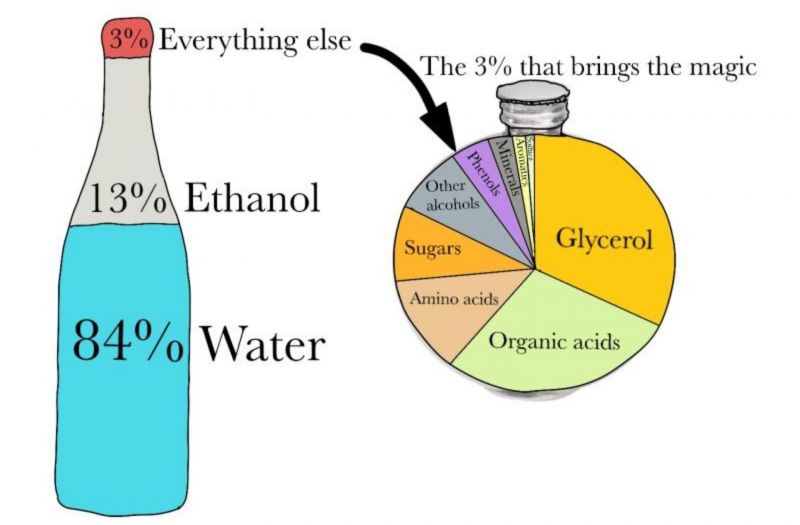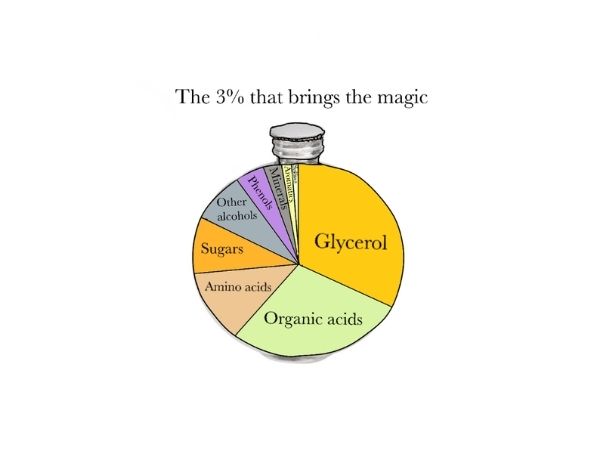Educating Sommeliers Worldwide.
By Beverage Trade Network

Sommelier Business joins with Nicolas Quillé, MW to create a short wine technical series to give on-trade professionals wine technical knowledge. In this article we write about wine basic composition.
The vast majority of wine is water (85%) and ethanol (between 8 and 16% for non-fortified wines). This leaves about 3% for everything else and this is what makes the differences between all wines. Those 3% are made of organic acids, residual sugars, phenolics, glycerol, other alcohols, amino acids, minerals, aromatics and sulfites. Most of what is in the wine comes from the grapes or from the transformation of grape juice into wine by wine yeasts. The only exception are a few additives that are hopefully added in minute quantities so not to alter the delicate balance of the precious 3%.
Ethanol comes from the transformation of grape sugar into alcohol by yeasts. It takes about 16 g/L of sugar to make 1% of ethanol. The sugars in grapes that are predominant are glucose and fructose. Yeasts prefer glucose often leaving residual fructose at the end of fermentation; importantly fructose is 2.4 times sweeter than glucose which makes wine sensory evaluation of low sugar concentration very hazardous. There are many other sugars in wines that play minor roles in the sensory appreciation of wine.

Glycerol is a byproduct of fermentation that increases the viscosity of wine. Its level is linked to the yeast type and is always higher when the sugar levels at harvest are high and the fermentation temperatures are elevated.
Organic acids provide the acidity of wines and push their pH of below 4.0. The primary grape/wine acid is tartaric and it exists at concentrations between 2.5-5g/l at harvest. Malic acid is the next most important at around 1-4 g/l. Malic is unstable and can be biodegraded into lactic acid by lactic bacteria (this is the secondary, or malolactic, fermentation). Next comes citric acid which is rarely at a concentration superior to 1 g/L. Acetic acid is produced by several microorganism during fermentation and aging and is responsible for the sour smell and taste of vinegar.
Grapes produce polyphenols to defend themselves against predators and to signal when a fruit is ready to consume to spread its seeds. Phenolics in wine are grouped in flavonoids & non-flavonoids. Non flavonoids are primarily acid phenols that have no recorded influence on sensory. Flavonoids are large molecules found in the skin, seeds and stems of grapes and are the building blocks of tannins, anthocyanins, and flavonols. Tannins are responsible for the astringency of red wines and anthocyanins are responsible for its color. Catechins are the subunits of tannins. Small tannins (less than 4 catechin subunits) are bitter. Flavonol are yellow polyphenols that may be behind the color of white wines.
Grapes are relatively rich in proteins and amino acids that will be substantially depleted by microorganisms during fermentations. After fermentations, the wine can be enriched in proteins by aging it on the dead yeast cells. The proteins from this process are rather large and grouped under the term of colloids. They are a mix of mannoproteins and polysaccharides. Proteins bind with tannins and precipitate; therefore red wines are poor in proteins. Since white wines are poor in tannins, they are richer in proteins to the point where they can become unstable and create a haze in the bottle.
Residual sugars are unfermented sugars post fermentation. They provide weight to quasi-dry wines (below 4 g/L) and of course contribute to the quality and richness of all sweet wines. When present in large amount and the alcohol is below 16% ABV, levels of RS above 4 g/L require sterile filtration to avoid any refermentation.
Grapes are relatively rich in potassium which is a major contributor to wine instability because it can create a salt with tartaric acid creating pretty crystals that look like broken glass at the bottom of a bottle of wine. Other minerals in grapes include calcium, magnesium, iron and copper.
Aromatic molecules are found in small amount and we distinguish the primary aromas that come from the grapes, the secondary aromas that come from the winemaking process and the tertiary aromatics that occur during aging. There are upward of 9,000 volatile molecules in wine.

Born in Lyon, France, from a family in the wine business for three generations. Nicolas has a Master degree in winemaking from the University of Dijon, Burgundy and a Master in sparkling winery management from the University of Reims, Champagne. Prior to coming to the United States, have worked in Burgundy and the Rhone Valley as a winemaker.
He came to the United States in 1997 and worked for J. Lohr and The Hogue Cellars as a winemaker. During his time at Hogue Cellars, he went back to school and earned a MBA with honors from the University of Washington (first of class). He was the General Manager and Winemaker for Pacific Rim for 10 years where I lead our two wineries making 600,000 cases of wine. He recently took a position as the Chief Winemaking and Operations Officer for the Crimson Wine Group supervising six prestigious estate wineries in OR, WA and CA. In 2018 he became a Master of Wine formerly joining the prestigious Institute of Masters of Wine.